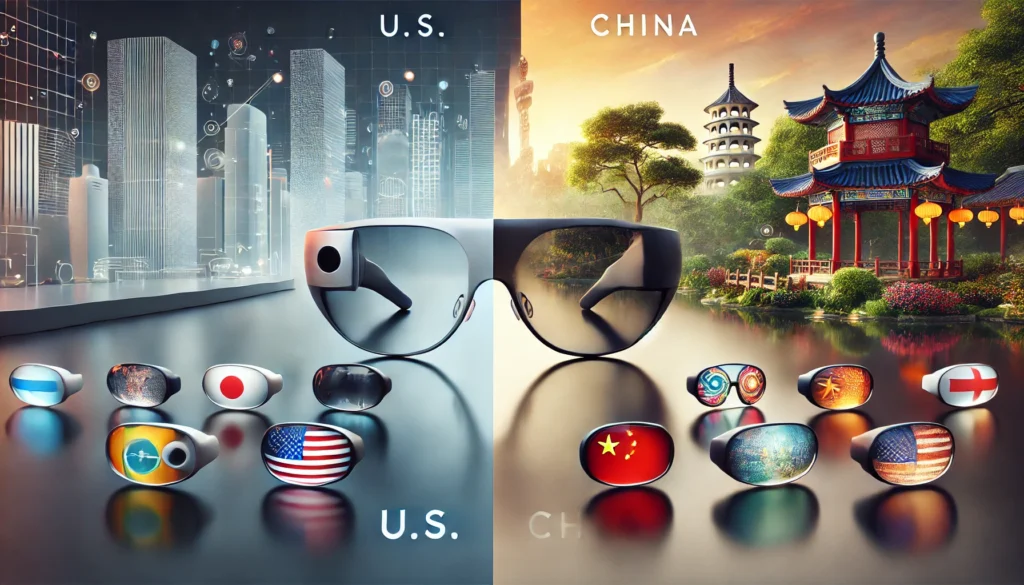As smart glasses rapidly carve out their place in the wearable tech landscape, the U.S. and China are emerging as key players—but with strikingly different approaches. While American tech giants focus on luxury and lifestyle, Chinese companies are taking a more practical and affordable route, highlighting the contrasting consumer expectations in these two powerhouse markets.
The U.S.: Where Luxury Meets Technology
In the United States, smart glasses are more than just a piece of tech—they’re a statement. Companies like Apple and Meta are positioning these devices as premium accessories designed to enhance both digital experiences and personal style.
Apple is leading the charge with its AI audio glasses, currently in development. These sleek, minimalist glasses are designed to seamlessly connect with Apple’s broader ecosystem, offering users an unparalleled blend of luxury and cutting-edge functionality. The tech giant is betting that its reputation for innovation and high-end design will make these glasses a must-have for the tech-savvy and style-conscious.

Meta, formerly known as Facebook, is taking a different but equally stylish approach. In collaboration with Ray-Ban, Meta has launched smart glasses that combine iconic fashion with advanced technology. Unlike traditional smart glasses that often feature intrusive displays, these focus on audio and AI, delivering a high-tech experience without sacrificing style. It’s a perfect match for consumers who want to make a fashion statement while staying connected.

China: Practicality and Affordability Lead the Way
On the other side of the globe, China’s smart glasses market is driven by a different set of priorities. Here, companies like Xiaomi are focusing on delivering practical, affordable technology that appeals to a broad consumer base.
Xiaomi, through its ecological chain company Honeycomb Technology, has recently introduced the Jiehuan 1 smart glasses. These glasses are all about personalization and practicality, offering “8 frames and 14 colors” to cater to individual tastes. Equipped with AI-powered voice interaction and translation services, they start at just 699 yuan, making them an attractive option for budget-conscious consumers looking for functionality without the hefty price tag.

Huawei and ByteDance, two other major players in China, are also integrating smart technology into conventional eyewear formats. Their goal is to make smart glasses a practical tool for everyday use, rather than a luxury item. While these products are innovative, they typically lack the brand prestige and marketing power that characterize their American counterparts.
Different Strategies, Different Consumers
The divergent paths taken by the U.S. and China in the smart glasses market reflect broader differences in consumer preferences and market strategies.
In the U.S., smart glasses are marketed as elite accessories, often introduced as part of a larger tech ecosystem. American consumers are drawn to products that offer a blend of luxury and technology, and they’re willing to pay a premium for devices that enhance their digital lives and social status.
In China, the focus is on practicality and affordability. Companies aim to deliver functional, cost-effective smart glasses that are accessible to a wide audience. For Chinese consumers, smart glasses are less about making a fashion statement and more about integrating useful technology into everyday life.
Conclusion: Two Markets, The Same Future
While the U.S. and China are taking different roads in the smart glasses market today, the underlying AI technology is steering them toward a converging future. Despite the contrasts in marketing strategies and consumer preferences, the core advancements in AI are shaping a similar trajectory for these products across both markets.
As AI technology continues to evolve, it will drive smart glasses to become more integrated, intuitive, and essential in everyday life—regardless of whether they are marketed as luxury accessories in the U.S. or practical tools in China. The AI capabilities embedded in these devices, such as voice interaction, real-time translation, and seamless connectivity, are universal in their appeal and utility.
For more insights into how AI is transforming the world of wearables, stay tuned to OpenWing.ai—your source for the latest in AIoT innovation.


